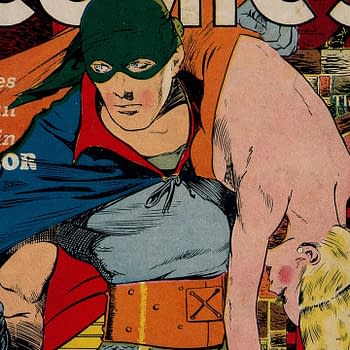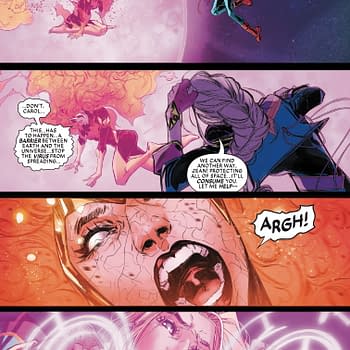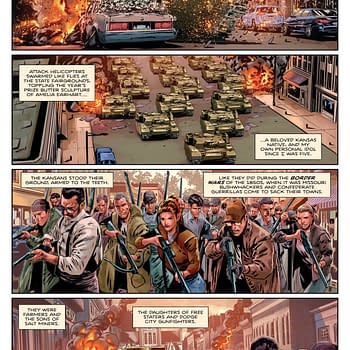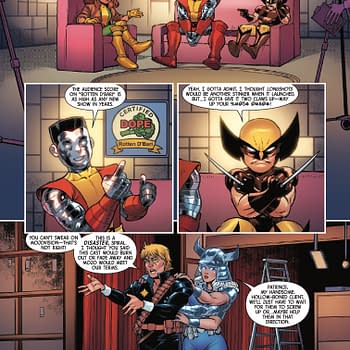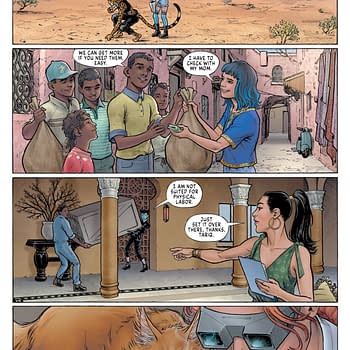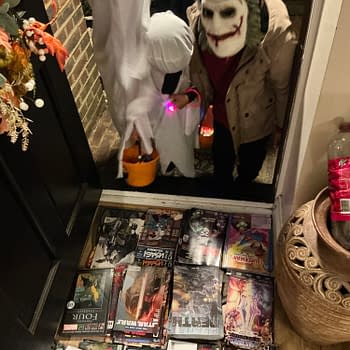Posted in: Comics | Tagged: Comics, entertainment, Injection, providence, Secret Wars
Thor's Comic Review Column: Injection #4, Giant Size Little Marvel AvX, Providence #3, And Secret Wars #5
This Week's Reviews:
Injection #4
Giant Size Little Marvel AvX
Providence #3
Secret Wars #5
Injection #4… And Stuff
By Adam X. Smith

So anyway…
When he was discussing his work on FreakAngels, Ellis once said that, if you're the kind of person who wants their comics to be tightly plotted and act like chapters in a book with an action or story beat every few pages, on the plus side at least it was given away for free online. Injection, with its sudden cliff-hangers just when things are getting interesting, liberal use of flashback and Ellis' proprietorily impermeable dialogue, seems to be taking his approach to comic book structure to its logical conclusion, albeit without the benefit of being free. Indeed, it's only in this most recent issue that he's stopped, took a breath and explained, even in part, what is going on and what the stakes are.
The core concept of the reveal is classic Warren – Maria Kilbride and her fellow teammates in flashback discuss over dinner the possibility of creating a literal ghost in the machine using a non-human intelligence, for the purposes of accelerating the growth of human scientific progress during what they predict to be an imminent prolonged plateau. It is pretty much self-evident that the monstrosity she encountered previously is that same intelligence gone awry, a lifeform known as the Injection that is replicating an incursion into deep history… or something, for reasons that only it, the characters, and probably Ellis, understand. And if it's not, it may well be something just as bad.
More importantly, we get to see why Maria first appears as a patient at a mental asylum, what she used to do for the government, and get a sense as to why she's still doing it: guilt. Whatever is the source of the strangeness at the heart of Injection, she sees it as her fault, and that there's a debt that she can never fully repay.
This review got really heavy. Let's change channel.
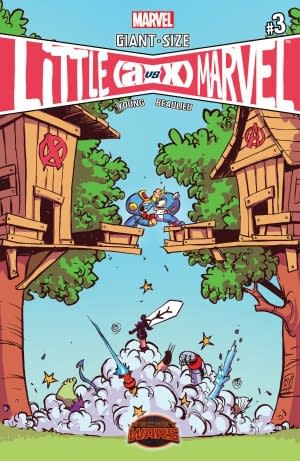
And yeah, it's fun. Not a hell of a lot of follow-up on that.
So next week, I'm thinking I maybe try and find a bit of structure – maybe catch up on some Adventure Time comics, or that second volume of Hacktivist they brought out for who-f*cking-knows-what reason. Hell, maybe I review something from like, a year ago that I haven't even had a chance to check out yet because reasons. I dunno. Comment with suggestions if you like. I am just Curious Adam at this point.
Final thought: Secret Wars #5 was kinda slow. Was that the one that threw the schedule off, or was that just a filler issue? Not bad, per se – just felt notably lacking stuff… you know, happening. Meh, just a thought.
Adam X. Smith is aware that this was a little thin on the ground this week – sometimes there's no way of making something bigger or longer or more meaningful than it naturally is, like your mother's mangos or your father's cucumbers. If you really feel compelled to check out more of his writing, @ElectrolyteMag has you covered.
Providence #3 (Avatar, $4.99)
By Cat Taylor
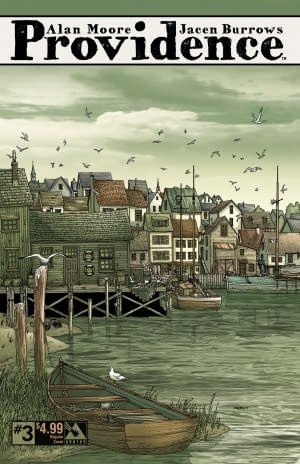
Although Providence can be read and enjoyed on its own terms as more of a mystery comic that is slowly moving into the horror realm, there are two ways to get a more complete picture of what's happening and where this is all leading. The first is to be thoroughly familiar with the books of Lovecraft because the references, call-backs, and material inspired by Lovecraft's works cover pretty much every page of the series so far. A second way to get more out of this series is to carefully read the pages of text at the end of each issue. Including several pages of supplemental text at the end of his comics has become a stylistic trademark of Moore's. When he did it in Watchmen, it provided additional background into that world that wasn't critical to reading the series, but made the experience more fulfilling and provided additional clues for observant readers without Moore having to result to lengthy exposition within the main story. In League of Extraordinary Gentlemen, it seemed more like a way for Moore to cram every literary and pop culture reference he could into his stories and for readers to play Easter egg hunt as they tried to see how many of those references they could recognize. In Providence, the text allows the reader somewhat of a third-person omniscient view of the story's proceedings by providing explanation about events in the main story. For instance, if I hadn't read those text pages, I wouldn't know why the villagers look like they do, or what was happening on the last page of this issue, or what was in those little talking bottles.
With or without the pages of text at the end, a lot of patience is required with Providence because the story is proceeding at a crawl with seemingly very little of significance happening so far. I probably wouldn't have stuck with it after the first issue if the writer were anyone other than Moore, but he's more reliable than not and he's never conventional. So, if he lives up to his standard quality, the payoff is going to be well worth the wait and will probably cause me to re-read the series to see what I missed the first time.
I also wanted to point out that I found the most memorable moment in this issue to be a dream sequence. Showing a dream in a comic book is nothing new but I don't think I've ever seen one put to page that really seemed like the way I dream. They are always far too coherent and sequential, despite any odd characters or swirly images thrown in to give them a touch of the surreal. On the other hand, the dream in this issue proceeds a lot like the way I actually experience dreams. Although, I don't recall ever having a dream where a dude was sitting beside me and "pounding off" while we talked, but maybe that's just me. At any rate, as the dream occurs in this issue, the scenes and characters change rapidly for no apparent reason and phrases of nonsense clutter the dialogue. All of that matches what I remember of my dreams far better than the dreams in other comics, movies, and television shows.
Something else you can usually count on in a Moore comic is a group of collaborators who aren't content to just produce average work. In Providence, the artist, colorist, and even the letterer do their best to add a little something extra to the story. In the case of letterer, Kurt Hathaway, it's subtle and most people won't consciously pick up on it, but he uses a slightly different font for the creepy villagers' speech than he does for the "normal folk." The colorist, Juan Rodriguez, applies varying hues to represent the different times of day and locations, but also adds bigger variances for other sequences. For example, that dream I mentioned earlier is portrayed in black and white. Also, flashbacks are in all sepia tones.
Finally, the artist, Jacen Burrows, is Moore's type of illustrator. His work is similar to other Moore collaborators like Dave Gibbons and Kevin O'Neill. Like those artists, Burrows draws his figures cleanly and simply. His focus is on making each character unique and drawing fairly realistically with only as much detail as necessary, as opposed to going for something more abstract and artsy. It's a style that Moore apparently enjoys writing around and it has always served his stories well. However, I feel like this would seem like more of a horror comic if Burrows had illustrated certain scenes as being creepier. Maybe the point is to have creepy events happen in a mundane setting but if this were a movie, how effectively scary the story would be so far would depend on a visually uncomfortable atmosphere. In this comic book on the other hand, I'm not feeling the sense of dread and unease that I know I should be experiencing. I know that there's a lot of evil and nastiness going on and eventually things are going to go batshit but I know that through "head" knowledge and not "heart" awareness.
I know it's kind of odd to review a series in the third issue like this, but with a writer like Moore, it's often difficult to tell where he's going in the early installments. While I would have liked to get the word out sooner, I'm pretty sure everyone knew about this series a while ago and would be buying it or not based on Moore's name alone and not because of what some dumb reviewer like me has to say. Besides, it's taken me three issues to really get the hang of what's going and where the story may be going anyway. At any rate, Providence is already ripe for fan discussion and critical analysis and will likely continue inspiring us to do so as the series continues.
Cat Taylor has been reading comics since the 1970s. Some of his favorite writers are Alan Moore, Neil Gaiman, Peter Bagge, and Kurt Busiek. Prior to writing about comics, Taylor performed in punk rock bands and on the outlaw professional wrestling circuit. During that time he also wrote for music and pro wrestling fanzines. Does anybody out there remember the Sanford and Son spin-off called Grady? Yep, that was a real thing. You can e-mail Cat at cizattaylor@hotmail.com.
Secret Wars #5 (Marvel, $4.99)
By Jeb D.
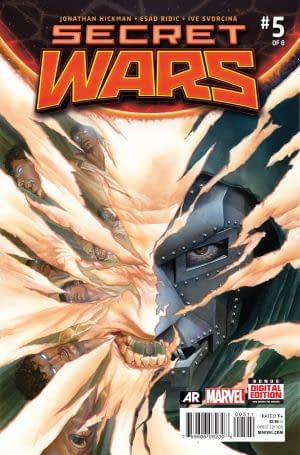
Which, of course, reinforces the interesting juxtaposition of Doom being trashed in the cinemas, and temporarily erased from active participation in the new Marvel Universe, while he is simultaneously the star of Marvel's biggest event comic for some time, a Doom story to equal any that have come before.
With the emergence of the trade paperback market, we became familiar with story arcs of six (and in a recent cost-cutting measure, five) issues; given that, it's natural to expect the fifth issue be the one that brings the story to a head before the big finish. But writer Jonathan Hickman's taken a novelistic approach to pacing this story, and issue #5 is more reflective, divided principally between two conversations: in the first, Doom and the Molecule Man fill in the backstory of the creation of Battleworld, including Doom's audacious last stand against the Beyonders; in the second, the God-Emperor tasks daughter Val with tracking down the heresy spreading through the various realms. Both exchanges are marvelous character pieces for Doom, the one with his beloved daughter particularly significant as it tempers the familial affection that Hickman's Doom has demonstrated with the imperious refusal to accept question, even from those closest to him, that has characterized the character from his beginnings. Most of the other developments this issue relate to the widening cracks in Doom's omnipotence, and when this is all over, I'm going to be darned sorry to see this glorious bastard brought low.
In a fairly quiet issue, artist Esad Ribic substitutes grandeur for action; Doom's been allowed his share of nobility over the years, but few artists have used their skill with posture and movement to make his armored body more expressive.
The intrusions of work, life, and other things have me hopelessly behind in my Secret Wars / Battleworld reading, and there's a panel or two here and there in this issue that I'm sure would have more impact if I were caught up on the ancillary stuff, but all in all, whether the whole thing succeeds as an "event," considered as a comic, Secret Wars is just a great read.
Jeb D.'s kinda busy.










